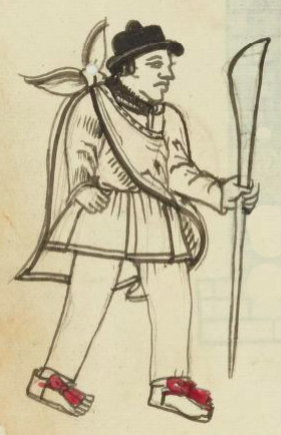macuiltecpanpixqui (MH612v)
This largely black and white simplex glyph (or, if not a glyph, then an example of iconography) shows a 3/4 view of a man, fully-dressed, wearing sandals with red ties, standing, and holding a huictli (an agricultural tool, a digging stick). The gloss suggests that his occupation is to oversee 100 tribute-payers. Perhaps their tribute is agricultural labor, as the tool itself can be a glyph for tequitl (tribute labor).
Stephanie Wood
The term breaks down into macuil- (five), -tecpan- (twenties), and -pixqui (keeper). This man wears Indigenous sandals (cactli) and a Native cape (tilmatli) tied at one shoulder. Holding the huictli agricultural tool may also be an indication that he is an agriculturalist of the barrio. Showing colonial cultural influence, this same man wears European-style clothing (a long-sleeve belted tunic and full trousers). His black hat is also European. The way he dresses and his occupation show that he enjoys some status locally. Even though he does not have the "don" nobility title by his name, he does have the -tzin reverential suffix on his Nahua name (Mixcoatzin, "Cloud Serpent").
The artist who painted this figure conveys some colonial influence in the artistic style he uses, such as hatch marks for shading and three-dimensionality.
Stephanie Wood
diego mixcouhuatzin macuiltecpapisgui
Diego Mixcoatzin, macuiltecpanpixqui
Stephanie Wood
1560
Jeff Haskett-Wood
officials, oficiales, tributes, tributos, tributarios, números, labor, trabajo, ciento, cien, hundred, coas, agricultura, huictli

macuiltecpanpixqui, keeper of one hundred tribute payers, https://nahuatl.wired-humanities.org/content/macuiltecpanpixqui
guardián de cien [tributarios]
Stephanie Wood
Matrícula de Huexotzinco, folio 612v, World Digital Library, https://www.loc.gov/resource/gdcwdl.wdl_15282/?sp=307st=image.
This manuscript is hosted by the Library of Congress and the World Digital Library; used here with the Creative Commons, “Attribution-NonCommercial-ShareAlike 3.0 License” (CC-BY-NC-SAq 3.0).



